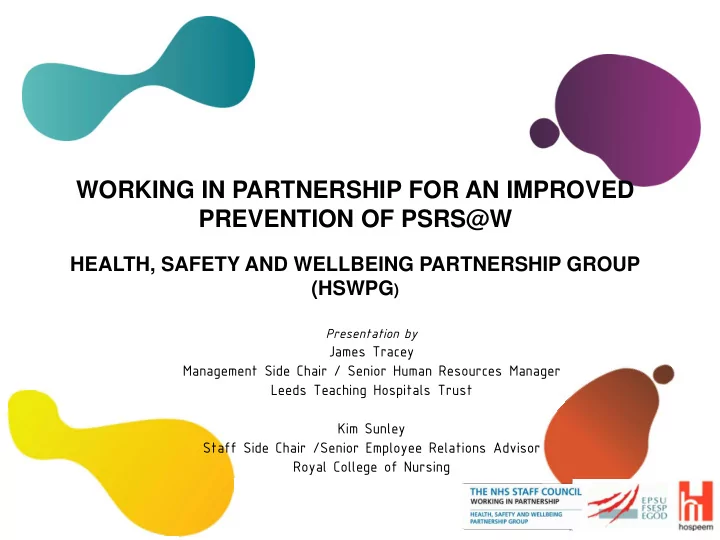

WORKING IN PARTNERSHIP FOR AN IMPROVED PREVENTION OF PSRS@W HEALTH, SAFETY AND WELLBEING PARTNERSHIP GROUP (HSWPG ) Presentation by James Tracey Management Side Chair / Senior Human Resources Manager Leeds Teaching Hospitals Trust Kim Sunley Staff Side Chair /Senior Employee Relations Advisor Royal College of Nursing
Introduction Who we the partnership group and what we do. What we have done to support the management of stress. Research conducted by Zeal Solutions. Statistics related to Stress in the UK. How it works in practice.
UK UK Soc ocial al Par artn tners ershi hip p Wor orki king ng Staff Council Main forum for England terms and conditions negotiations Job Equality and Working HSWPG Evaluation Diversity Longer Review UK Reports (NHS Scotland / Wales / N.Ireland)
Health, Safety and Wellbeing Partnership Group - HSWPG Social Partners are: Management. Staff Side. Special interest groups: Health and Safety Executive. NHS Protect. Institute of Occupational Safety and Health.
What we do Our raison d’etre is to work in partnership to deliver: A rise in standards of workplace health, safety and wellbeing in healthcare organisations. Promote a safer working environment for health staff. Promote partnership working at all levels. We do this through providing: Advice and guide books Communicating good practice Responding to consultations Research.
Effective partnership working Value of working in partnership. Role of representatives. Importance of consultation. Joint working through committees and inspections.
UK definition The Health and Safety Executive (HSE) define work related stress as: “The adverse reaction people have to excessive pressures or other types of demand placed on them at work”
HSE Management Standards • Role • Control • Demands • Relationships • Change • Support
HSE Stress Assessment Tool 35 questions Questions relate to Management standards Designed to be completed by teams Results indicate against which of the standards has highest risk
Example of results for RCN Members 5 4,61 4,27 4,03 4 3,77 3,56 3,54 3,44 3,32 3,08 3,08 3 2,61 2,50 Nursing staff 2 UK 1 0 Demands Control Managerial Peer Role Change support support 1 = low wellbeing 5 = high wellbeing
HSE Stress Action Plan
Case for stress management Chartered Institute of Personnel and Development (CIPD) found stress the biggest reason behind sickness absence in UK. Over 40% UK organisations seen an increase in mental health problems ( CIPD 2015 Annual Absence Report ). Annual NHS Staff Survey states over 30% of NHS staff suffer from stress every year. Cost of stress in UK annually £1.24 billion ( € 1.67 billion), resulting in loss of 105 million days ( Health & Safety Executive ).
Case for stress management Source: Work related Stress, Anxiety and Depression Statistics – Health and Safety Executive October 2015
Health and Wellbeing in Healthcare Settings Diagnosis – through health and wellbeing audit. Feedback – face to face engagement to understand results. Action – reports provided to NHS organisations and action plans agreed. Evaluation – organisations revisited and evaluated.
What the research identified The following features have a POSITIVE effect on health: A positive team culture. Supportive management behaviours. Positive contribution. Participation Being kept informed
What the research identified The following features had a NEGATIVE effect on health: Work overload. Poor equipment Lack of Resources. Difficult home-work balance. Work related violence.
Summary of research Supportive management behaviours counteracts potential risks. Individual health related negatives: eg: stress, burnout. Performance negatives: Poor patient outcomes, rise in complaints. Negative attitudes: Low engagement, morale, satisfaction. Poor performance indicators High absence, turnover.
Guidance on prevention and management of stress Definitions of stress. Impact of organisational change on stress at work. Identifying stress in the workplace. Stress policy development. Effective management behaviours. Working in partnership to tackle stress.
Guidance - General Effective Stress Policy. Statement of intent, context and defintions. Audit to identify stress (HSE Indicator Tool). Staff involvement in agreeing priorities. Utilise organisational resources. Clarifying responsibilities.
Guidance - General Working in Partnership. Safety representatives. Occupational Health. Community Mental Health services. National Mental Health Charities (MIND).
Guidance - Managers How to use information to understand where risk can occur. How organisational change impacts on stress. Understand how their behaviour impacts on workplace stress. Make reasonable adjustments.
Summary Health, Safety and Wellbeing Partnership Group believes working in partnership to combat work related stress is essential. Management behaviour has a significant impact. An effective policy is essential. Act quickly to reduce impact. Use measures to determine level of stress.
Thank you for listening… http://www.nhsemployers.org/your-workforce/retain-and- improve/staff-experience/health-work-and-wellbeing/protecting- staff-and-preventing-ill-health/partnership-working-across-your- organisation
Recommend
More recommend